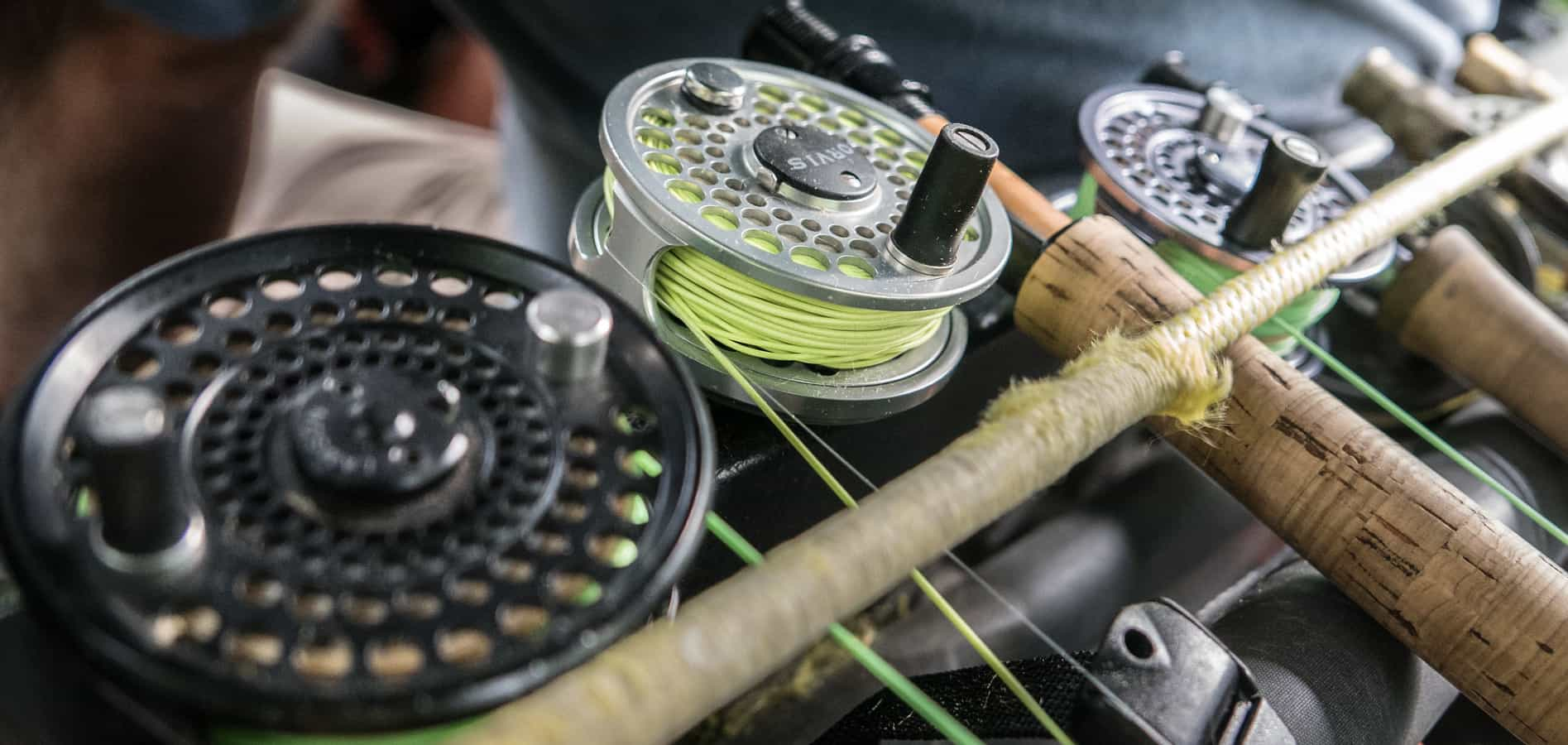Ask MidCurrent: Understanding the Fly Rod and Line Weight System

Image by David Lambroughton
Question: What’s the origin of the weight system for fly lines and rods? How is it determined that this rod and line is a 5-weight while this rod and line is a 4-weight?
Answer: Few changes have been as hugely impactful to the fly fishing universe as the standardization of fly line and rod weights. And this system, now taken for granted, has a rich and interesting history. This is the story, condensed of course, of how fly fishing found its common language.
The Early Days: A Tangle of Confusion
Imagine walking into a fly shop in the 1940s, eager to pair a new rod with the perfect line. Standard procedure nowadays, right? But back then, the fly fishing world was a jumble of inconsistent designations and confusing labels. Manufacturers used various letter systems for fly lines creating a confounding bird’s nest of coded labels, leaving anglers to pick through the mess and hope they follow the right line (so to speak) to a solution.
This lack of standardization wasn’t just a minor inconvenience—it was a significant barrier for anglers. Matching rods with appropriate lines was a game of guesswork, often leading to frustration and subpar fishing experiences. It was like trying to tie a perfect knot with your eyes closed—possible, but far from ideal.
Enter Myron Gregory: The Visionary Behind the Weight System
One man’s vision transformed the chaos of fly fishing gear into order. That man was Myron Gregory, and his impact on our sport cannot be overstated.
In the late 1950s and early 1960s, Gregory, an avid pistol shooter and competitive fly caster, recognized the need for a reliable, standardized system of measurement for fly lines. His background in precision shooting likely influenced his approach to this problem, much like how skills from one type of fishing often translate to another.
Gregory’s brilliant idea was to base the system on the weight of the first 30 feet of fly line, measured in grains. Why 30 feet? Well, any experienced angler knows that’s typically the amount of line you’d have out of the rod tip when making a cast. It’s these kinds of practical, on-the-water insights that make Gregory’s system so effective.
The AFTMA Standard: A New Era Dawns
Given its intuitive simplicity, Gregory’s system caught on fast. It was soon adopted by the American Fishing Tackle Manufacturers Association (AFTMA), now known as the American Fly Fishing Trade Association (AFFTA). This standardization became known as the AFTMA standard, and it revolutionized the way we categorize and match fly lines and rods.
Decoding the Weight System: What Makes a “5-weight”?
The AFTMA standard assigns a number to each fly line based on its weight in grains for the first 30 feet. This system typically ranges from 1-weight (lighter than a whisper) to 14-weight (heavy enough to punch through a stiff saltwater breeze).
So, what makes a line a ‘5-weight’? Under the AFTMA standard, a 5-weight fly line should weigh between 134 and 146 grains for the first 30 feet. Here’s a quick reference guide for some common line weights:
- 4-weight: 120-127 grains
- 5-weight: 134-146 grains
- 6-weight: 152-168 grains
- 7-weight: 177-193 grains
- 8-weight: 202-218 grains
This standardization opened up a world of possibilities. Anglers could now easily match their lines to their rods, improving casting performance and overall fishing experience.

“A four-weight creek.” Image by Michael Edgerly
The Logic Behind Specific Weight Numbers
You might be wondering: “Why these specific numbers? Why not start at 1 and go up by 10s?” When Gregory developed this system in the late 1950s, he wasn’t just pulling numbers out of thin air. He aimed to create a scale that would encompass the range of fly fishing scenarios common at the time, from delicate presentations on small trout streams to battling saltwater giants.
Practical Increments
The numbering system was designed with the angler in mind. It provides meaningful distinctions between line weights without creating so many categories that it becomes confusing. Each increment represents a noticeable difference in performance and application. It’s like the difference between a size 14 and a size 16 fly—small enough to be precise, but large enough to matter.
Alignment with Existing Practices
Here’s something many folks don’t realize: before standardization, many manufacturers were already using similar numerical designations, albeit inconsistently. So Gregory’s system didn’t reinvent the wheel; it simply made sure all the wheels were rolling in the same direction.
Why These Specific Numbers?
The choice of numbers like 4, 5, 6, and so on serves several purposes:
- Simplicity: Single-digit numbers are as easy to remember as your favorite fishing spot.
- Range: The system starts at 1 (ultra-light) and goes up to 14 (heavy saltwater), covering everything from delicate spring creek fishing to battling marlin.
- Incremental Progression: Each number represents a logical step up in weight and power. It’s like moving from a 9-foot 5X leader to a 9-foot 4X—a subtle but meaningful difference.
- Flexibility: The system allows for half-weights (e.g., 4/5 or 5/6) for those in-between situations, much like how you might fish a fly in between sizes.

“Throwing the old stuff.” Image by Mark Sides
The Middle Ground: 5-weight as a Benchmark
Now, let’s talk about the 5-weight. It’s become something of a benchmark in fly fishing, particularly for trout. But this wasn’t part of some grand plan—it evolved through use, like a favorite fly pattern that just seems to work everywhere.
- Versatility: 5-weight setups offer a good balance of delicacy and power for a wide range of freshwater fishing situations. It’s like the Swiss Army knife of fly fishing—not always perfect, but rarely wrong.
- Historical Precedent: Many popular rod designs from the pre-standardization era aligned closely with what became the 5-weight standard. It’s as if the industry had been circling around this sweet spot for years.
Beyond Numerical Order
While these numbers do provide a clear order, their significance goes beyond mere ranking:
- Application Guidance: Different weights are associated with specific types of fishing. For instance, 2-3 weights for small streams, 5-6 for general trout fishing, 8-9 for light saltwater use, etc. It’s like having a roadmap for your fishing adventures.
- Performance Expectations: Each weight number carries implicit information about the expected performance characteristics of the rod and line. An 8-weight rod tells you a lot about its intended use before you even pick it up.
Rod Weights: A Crucial Pairing
With fly lines standardized, rod manufacturers could design their products to perform optimally with specific line weights. A 5-weight rod, for instance, is engineered to cast a 5-weight line with optimal efficiency. This marriage of rod and line weights brought a new level of precision to our sport.
Modern Challenges: When Standards Start to Drift
Just as a river constantly shapes its banks, the fly fishing industry continues to evolve. In recent years, we’ve seen some interesting developments that have added new wrinkles to our weight system.
The Rise of Overweighted Lines
Many fly line manufacturers have started producing lines that are heavier than the AFTMA standard. It’s not uncommon to find a modern 5-weight line that actually weighs closer to a 6-weight or even a 7-weight by the original standards.
Why the shift? Well, it’s partly driven by marketing claims of improved casting performance, especially for beginner anglers. It’s like adding a bit more weight to your nymph rig—it can make it easier to cast and feel the line, but it might sacrifice some delicacy.
The Ripple Effect on Rod Design
This trend towards heavier lines has had a significant impact on rod design. Rod manufacturers have had to adapt their products to perform well with these heavier lines while still maintaining their nominal weight ratings.
It’s created a situation where an 8-weight rod might be designed to cast lines ranging from 210 to 350 grains in the first 30 feet, far exceeding the original AFTMA standard. It’s like the difference between a fast-action and a slow-action rod—they might have the same weight rating, but they perform very differently.

“Never too many.” Image by Mark Sides
Navigating the Modern Fly Fishing Landscape
Given these changes, how can anglers ensure they’re selecting the right equipment? Here are some tips from an old hand:
- Test before you buy: Whenever possible, try different line and rod combinations before making a purchase. You want to test the waters before committing.
- Consider your fishing style: Heavier lines can be beneficial for certain fishing techniques or conditions, just like how you might choose a heavier tippet for streamer fishing.
- Read reviews and seek advice: Tap into the collective wisdom of the fly fishing community. Experienced anglers and reputable gear reviews can provide valuable insights into how different rods perform with various lines.
- Pay attention to grain weights: Some manufacturers now list the actual grain weights of their lines, which can be more informative than the nominal line weight. It’s like checking the actual breaking strength of your tippet, not just the X-rating.
The Future of Fly Fishing Gear Classification
As our sport continues to evolve, there’s ongoing debate about the future of gear classification. Some industry experts suggest that listing grain windows for single-handed rods, similar to what’s done for two-handed rods, could provide more clarity for anglers.
However, implementing such a change across the industry would be a significant undertaking—like trying to change the direction of a mighty river. For now, education remains key. Understanding the history and current state of the weight system can help fly fishers make more informed decisions about their gear.
The Legacy of the Weight System
The weight system for fly lines and rods, born from Myron Gregory’s work in the mid-20th century, brought much-needed standardization to our beloved sport. It’s like the development of the fly fishing vest—once it was introduced, anglers wondered how they ever managed without it.
This numbering system has proven remarkably durable, continuing to serve as the foundation for fly fishing equipment classification despite significant advances in materials and design. Its simplicity and flexibility have allowed it to adapt to new fishing techniques and technologies while maintaining a consistent language for anglers and manufacturers alike.
While recent trends in overweighted lines and adaptive rod designs have added some complexity to this once-clear system, its foundation remains strong. The AFTMA standard continues to form the basis of how we categorize fly fishing gear, even as the industry pushes its boundaries.
As we look to the future, it’s clear that the weight system will remain a crucial aspect of gear selection. Whether through new standards or improved education, the goal remains the same: to help anglers find the perfect balance between rod and line for the best possible fishing experience.
So the next time you pick up your favorite 5-weight rod, take a moment to appreciate the history and thought behind that simple number. Understanding this context helps us appreciate why these specific numbers were chosen and how they relate to the practical aspects of fly fishing.











